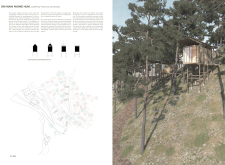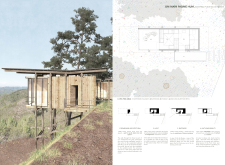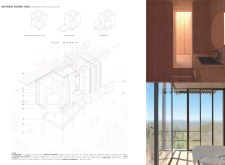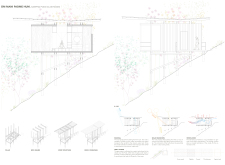5 key facts about this project
The "OM MANI PADME HUM - Sleeping Pods Val de Moses" project integrates architecture with the surrounding landscape in Val de Moses. Inspired by traditional structures like the espigueiros and horreos, the design features individual sleeping pods arranged within a larger framework. This approach emphasizes environmental stewardship and invites occupants to engage with nature while addressing their needs for rest and reflection.
Contextual Integration
The design thoughtfully incorporates the natural topography of Val de Moses. Pods are positioned among trees, which enhances the connection between built forms and the environment. The roofs of the sleeping pods are designed to collect rainwater efficiently, supporting the goal of sustainability. By allowing each pod to utilize collected water, occupants can enjoy a more self-reliant living experience that respects local resources.
Spatial Experience and Light
The interior layout aligns with the mantra "om mani padme hum," creating a physical journey that mirrors a spiritual path. Occupants transition from darker, more introspective spaces to areas flooded with natural light. This careful use of light promotes clarity and calmness, reflecting how thoughtful design can influence mood and well-being. Each space is designed to encourage personal reflection while connecting individuals to their surroundings.
Material Considerations
The materials chosen for construction include concrete for foundations, wood for structural elements, and cross-laminated timber (CLT) slabs. These materials are selected for their strength and sustainability. Using local resources helps to create harmony with the site, reducing the project’s ecological impact. The roofs not only capture rainwater but also facilitate greywater reuse, promoting responsible water management through natural processes.
Functional Diversity
The sleeping pods serve multiple purposes, allowing for activities like sleeping, relaxing, reading, and practicing yoga. This multifunctionality supports a way of living that values both personal space and community interaction. The arrangement of spaces invites users to engage with each other while promoting well-being. It creates opportunities for quiet reflection or communal gathering, reflecting the diverse needs of occupants in a peaceful atmosphere.
Natural Elements
Attention to detail is evident in how the built environment interacts with the landscape. The positioning of the pods alongside trees, integrated with natural plants for water filtration, enhances the visual appeal while promoting ecological balance. This connection between design and nature is an important aspect, emphasizing how the environment can contribute to a sense of calm and comfort for those who stay in the sleeping pods.






















































